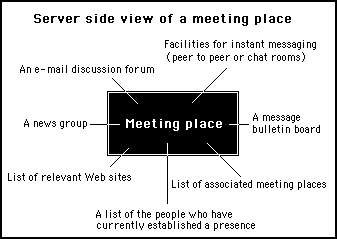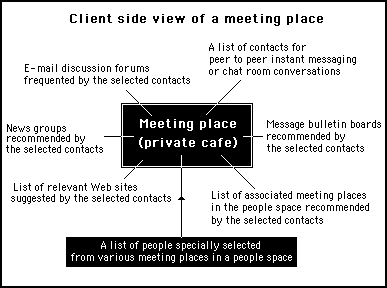
Chapter 11
The enigmatic world of bots and personal agents
Structure of a meeting place
At the end of the last chapter, the reader might have formed some kind of an idea as to what form a meeting place in a people space might take. It would probably be imagined as an area on a Web site where there are various options allowing the visitors to join an e-mail discussion forum, a news group or a chat room. Certainly a meeting place can be structured in this way, but, this would be a conventional server side view where all these facilities were laid on. This is illustrated in figure 11.2 which shows the meeting place as it was depicted in the last chapter.

Figure 11.2
A meeting place in a people space as it might be viewed with a server side perspective
However, this idea of a meeting place doesn't accord with the notion of every individual having their own private meeting place within their own computer, where they have complete control of the topics of discussion. This is where another sharp paradigm shift is needed.
Return now to the vision of meeting places in a large city where you go just to observe and find people you like the look of. You then invite these selected people back to your place for a party. At this party, you find out what their interests are and what interesting places they frequent. If the places they go to sound interesting you might arrange to meet them at these places. You might get their telephone number in order to have private conversations with them. You might invite them to a small dinner party you arrange for a selected few, like minded people. This is the way social contacts are created and cultivated in the social world of bricks and mortar.
This scenario can easily be emulated in the virtual world of the Internet. If the meeting places in the people space are treated as contact areas where people with a particular common interest establish a presence, everyone has an opportunity to invite any of the people who are there back to their place to maybe develop further contact and associations.
In this way, it isn't essential for the server side to arrange discussion forums, news groups or chat rooms. People could just tell each other of the e-mail forums, news groups or chat rooms they frequent. In other words, the people themselves could provide links to existing facilities for communication that are already in existence outside of the people space – established anywhere in the vast landscape of the Internet environment.
The people can swap e-mail addresses for one to one correspondence. They can arrange to be on each others lists for peer to peer instant messaging. They can form small groups for discussions in the way tables in a virtual cafe are designed to operate. Seen in this way, the people at the meeting places are capable of combining to create their own communication environments, which would be far richer and more extensive than any that could be organised on the server side.
It takes quite a radical paradigm shift to see what is happening here, as the idea of a publicly shared meeting place is transformed into a variety of individual meeting places in the virtual cafes in people's own computers.
Consider: every person at a meeting place is likely to have their own personal communication environment. When people are invited into a private cafe environment outside of the people space, their individual communication environments would have to move with them because it is part of them. Thus by bringing several contacts into a personal virtual cafe, you are effectively creating a rich communication environment which includes all of the personal communication environments of all the people invited.
This is illustrated in figure 11.3, where the contacts brought into a personal client side cafe can provide the client with a far richer environment of possible meeting places and facilities to communicate than would be available at the meeting places provided by the organisers of the people space.

Figure 11.3
A client side meeting place that is filled with contacts obtained from various meeting places in a people space. The client now has a far richer environment and choice of communication facilities available
Having a conventional, bricks and mortar world perspective, makes it very difficult to appreciate the full significance of this arrangement. The media of the Internet allows a phenomenon to take place that would be impossible in the real word: people can have multiple presences such that they can be at a meeting place in their own computer and at the same time be at meeting places in the computers of lots of other people. The magic of the net allows people to be at many places at the same time.
Not only this, everyone can create their own individual communication environment according to who they invite into there personal cafe of contacts. This is because a contact represents not only themselves, but, all the people they know, the newsgroups they belong to and the discussion forums they take part in.
This ties up with the ideas that were introduced at the beginning of the book – in chapters one and two – where, by having a suitable group of people in a personal cafe of contacts, an ordinary individual can become a "super individual". Not so much through direct communication with the contacts themselves but by having indirect access to all of their communication environments.